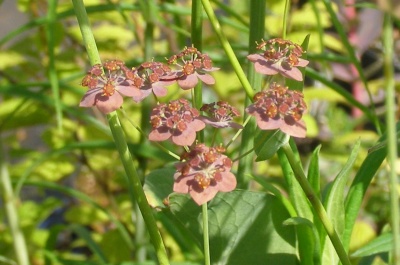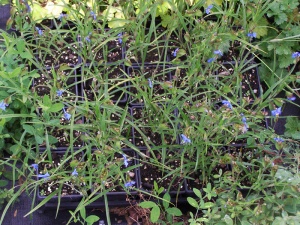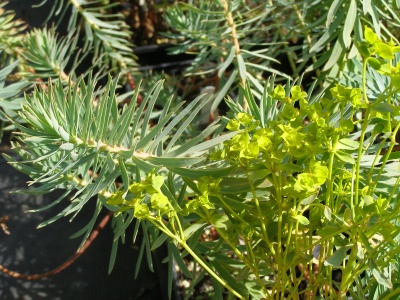Perennials
Very large dark blue flowers which are double but usually only with two sets of petals and therefore open in the middle. Typical leaves. Clumping and running when happy. Vigorous. 75 to 90cm. June /July. Sun or part shade. Joe Sharman named this one for its resemblance to old-fashioned ladies bloomers.
Spectacular, loosely double flowers in bright orange-red with bright yellow tips which enlage as the season goes. Very bushy, not as hardy as some. Fine greyish leaves. 60 - 75 cm. Early Oct to Nov
Many tiny fully double flowers in a very intense magenta. 75cm. November. Bred by Clive Hester.
Medium-sized, double yellow flowers in dense clusters. Yellow eyes. Tall to 90 cm. Late October to November.
Fully double, large, rich orange flowers, very long in flower, 60-75 cm.(July) October and November
Many, pale blue, three-petalled flowers over a long period. Very narrow green leaves. 30cm. Late summer. Deciduous. Seems to be completely hardy. Makes small tubers. A selection made by Joe Sharman from the normal dark blue form. Beautiful and still surprisingly rare.
Flowers larger than usual and very sweetly-scented. However, the unique character is the leaves which are a rich golden yellow. Leaves are large, like its parent. Very vigorous and running when happy. To 30cm. May. Dryish soils in part shade. Too shady and it will go green, too sunny and it will bleach a bit. Selected from the polyploid 'Hardwick Hall' by Margaret Owen.
Medium-sized "Decorative" flowers in white and red. The flowers are sectorially variegated with areas or rarely whole flowers being one colour or the other. 1m. Any soil in sun. Will survive outdoors in light soils if mulched in winter. Late summer and autumn. Rare. We would welcome a name for this plant. Formerly sold as "unnamed cultivar".
Short-growing with very rich blue flowerheads over dark green, silver-backed leaves. Clump-forming. 80cm. Any well-drained soil in sun. July/August. Surprisingly rare. Our form is from Graham Thomas and is darker flowered and shorter than other forms we've seen.
Many white flowers in marble-sized heads on stiffly-branching stems. The pale green leaves are sword-shaped, arching and produced in rosettes. The margins are set with many bristle-like teeth. Upright to 75cm. July / August. Totally hardy. Very tough growing in dry sun or part shade.
Many blue-tinted flowerheads surrounded by silvery bracts, on very branched arching stems. Leaves distinctly three-lobed. Large clumps. 75cm. Any soil in sun. July/August. Still worth growing.
Spectacular purple, cream and green flowers in late summer. In short spikes to 40cm with a pineapple-like ruff of spotted leaves on top. Very distinctive rosettes with purple spots underneath. The hardiest species. Sun or part shade in a dry spot.
The flowers are pale yellow to green in 80cm long spikes, with a distinct pineapple-like ruff of leaves on the top. Huge rosettes of broad green leaves with distinctively serrated edges. To 150cm tall. Late flowering and has proved hardy with us, but plant deeply.
Many heads of yellow flowers. Makes wide-spreading mounds of many narrow blue-green leaves. Pinkish stems. Well-drained soil in sun. 30cm. June/July. A hybrid of E. nicaeensis and seguireana discovered by Tim Ingram.
Rich golden-yellow heads of flowers to 20cm across. Narrow, pale green leaves to 8cm long with paler midribs on beautiful, wiry, pinky-orange stems. To 1m high and 2m across. An established plant will flower a full 12 months of the year. Very dry, in full sun. Can be cut back by a hard winter but very rarely killed. Collected by John Raven in the 1970s in Sicily.
A very beautiful diminutive herbaceous plant with bright blue, yellow-centred flowers and dark green, daisy-like basal leaves. Very hardy to minus 14C. 15cm. Damper soils soil in sun. May/June.





.jpg)


.jpg)

.jpg)
.jpg)
.jpg)

.jpg)
.jpg)
.jpg)
.jpg)

.jpg)
.jpg)
.jpg)

.jpg)
.jpg)
.jpg)

.jpg)






